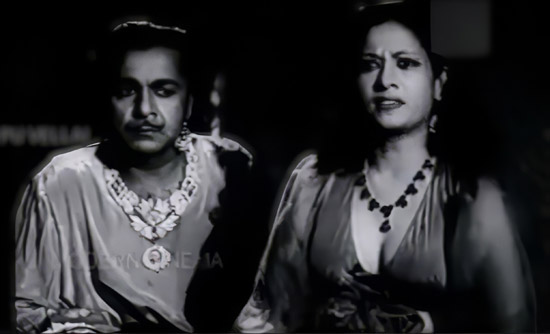Tamil cinema’s glamour heroine from Ceylon
An exhibition on a pioneering Tamil actress of a bygone era- ‘Vanamohini: Actress Thavamani Devi—From Ceylon to Madras’ was organised by the Art Circle of the University of Jaffna’s Department of Fine Arts. Held from September 4-8 at the Department’s Art Gallery, it featured her film clips, songs, documentaries on her, as well as family photos, film advertisements and stills.
This exhibition was held in parallel with the 10th Jaffna International Cinema Festival.

Thavamani Devi in Rajakumari-1947
Unlike other heroines of early Tamil cinema, Thavamani Devi (1924-2001) hailed from a wealthy family. Her father Kathiresu was a High Court Judge. Thavamani was born in Inuvil and grew up in Colombo, Kandy and Jaffna where she gained proficiency in English, Sinhalese and Tamil.
Thavamani was also trained in Carnatic music and Bharatanatyam –as per the ‘custom’ of the elite households in those days. Her language proficiency and her training in classical music brought her opportunities to sing on Ceylon Radio, when she was young.
Apart from being a Tamil actress, she was also a well-known playback singer, who was the first to sing songs with Tamil and English words. Ceylon Radio described her as the “Ceylon Cuckoo”.
Lawyer and MP, Vaiman Kathiravetpillai Balasingam, whom Thavamani Devi referred to as her uncle, was the one who introduced her to Thiyagaraja Bhagavathar, a prominent Tamil actor.
This was a turning point. She went on to become an actress who earned four times more than Thiyagaraja Bhagavathar.
Ellis Dungan, who was in Sri Lanka in the mid-1930s and directed Tamil movies, encouraged her entry into the world of cinema. “Music and Dance for Household Women: My Journey to Cinema” (1937), one of her articles published in Eelakesari elaborates how she got her family’s consent. It was an age when women were strictly forbidden in the public artistic realms. This article also highlights the scholarship of a liberated modern woman.
R. R. Sundaram’s Sathi Agalya (1937) was her first film. Sundaram was highly influenced by the Hollywood film industry and established modern theatres.
Vana Mohini (1941) earned her an important place in Tamil cinema. This was the Tamil adaptation of Jungle Princess (1936) which starred the Hollywood actress Dorothy Lamour. This movie was seen as an important milestone in commercial cinema, centring on the female characters. It was also an outcome of capitalist society – objectifying woman. Thavamani Devi became the first glamour actress in Tamil cinema, subjected to the male gaze. Julia Mulvey explains this from the view point of a male dominated society.
Glamour was seen in terms of body, make-up, hairstyle, attire and ornaments. Thavamani Devi was viewed in this light as a dream, an angel of an enchanted world, on the lines of Hollywood cinema, where glamour was seen as an important investment.
Thavamani Devi’s image and her political perspectives, which were constructed by her background and education however, challenged her existence in cinema – a realm which was highly male-dominated. With Vijaya (1951), her dreams of becoming a director and producer were shattered.
In 1962, she came to Rameswaram and married Kodilinga Sastri. However, her interviews continued to reflect her scholarship and criticism of the world of cinema.
Searching for an ideal partner? Find your soul mate on Hitad.lk, Sri Lanka's favourite marriage proposals page. With Hitad.lk matrimonial advertisements you have access to thousands of ads from potential suitors who are looking for someone just like you.


